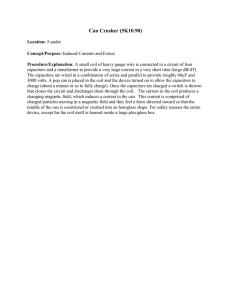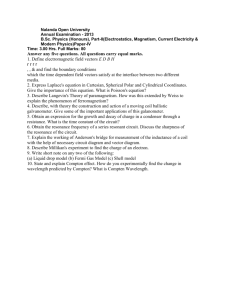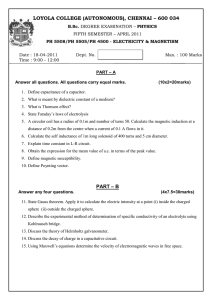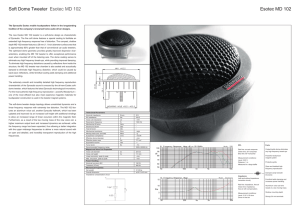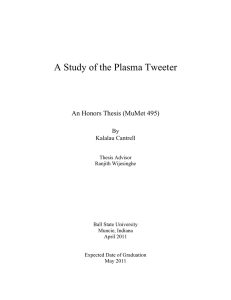High Voltage Rock`n`Roll
advertisement
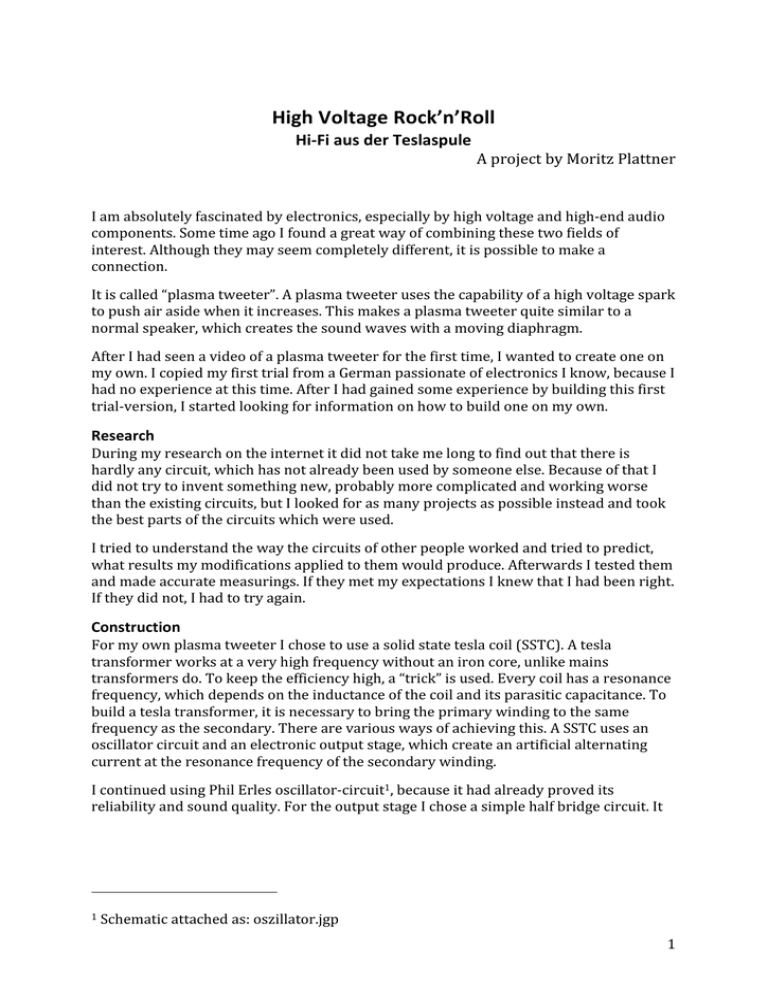
High Voltage Rock’n’Roll Hi‐Fi aus der Teslaspule A project by Moritz Plattner I am absolutely fascinated by electronics, especially by high voltage and high‐end audio components. Some time ago I found a great way of combining these two fields of interest. Although they may seem completely different, it is possible to make a connection. It is called “plasma tweeter”. A plasma tweeter uses the capability of a high voltage spark to push air aside when it increases. This makes a plasma tweeter quite similar to a normal speaker, which creates the sound waves with a moving diaphragm. After I had seen a video of a plasma tweeter for the first time, I wanted to create one on my own. I copied my first trial from a German passionate of electronics I know, because I had no experience at this time. After I had gained some experience by building this first trial‐version, I started looking for information on how to build one on my own. Research During my research on the internet it did not take me long to find out that there is hardly any circuit, which has not already been used by someone else. Because of that I did not try to invent something new, probably more complicated and working worse than the existing circuits, but I looked for as many projects as possible instead and took the best parts of the circuits which were used. I tried to understand the way the circuits of other people worked and tried to predict, what results my modifications applied to them would produce. Afterwards I tested them and made accurate measurings. If they met my expectations I knew that I had been right. If they did not, I had to try again. Construction For my own plasma tweeter I chose to use a solid state tesla coil (SSTC). A tesla transformer works at a very high frequency without an iron core, unlike mains transformers do. To keep the efficiency high, a “trick” is used. Every coil has a resonance frequency, which depends on the inductance of the coil and its parasitic capacitance. To build a tesla transformer, it is necessary to bring the primary winding to the same frequency as the secondary. There are various ways of achieving this. A SSTC uses an oscillator circuit and an electronic output stage, which create an artificial alternating current at the resonance frequency of the secondary winding. I continued using Phil Erles oscillator‐circuit1, because it had already proved its reliability and sound quality. For the output stage I chose a simple half bridge circuit. It 1 Schematic attached as: oszillator.jgp 1 is built out of two power‐MOSFETs2 and used in many similar projects. A full bridge would be a bit more efficient, but also much more complicated. The driver3 was more complicated. To drive a half bridge made out of MOSFETs efficiently, a galvanically isolated square wave signal for each gate is required. One signal has to be inverted, the other one not. The shorter the rise and fall times of the signal are, the less power is “lost” and converted into heat. Providing these signals is the task of the driver circuit. The first version I tried was built out of two TC44524. Two optocouplers5 provided the galvanic isolation from the oscillator circuit. It worked fine, but at 150V bridge voltage the output stage and both TC4452 died with a loud bang and a large amount of smoke. I still don’t know what happened exactly, but it seems that the magnetic field of the coil interfered with the signal inverter so much, that accidentally both FETs conducted at the same time. This caused a short circuit, which destroyed both MOSFETs. After this disastrous test I moved back to the gate drive transformer (GDT) I had already used in the first trial version. A gate drive transformer is a small transformer with, in my case, two secondary windings. If it is connected in the right way, the GDT creates the two galvanically isolated and opposite signals. Of course the GDT needs a square wave signal at its primary winding. This is provided by two TC4452. Conclusion This version works perfectly and I have currently about 3cm of small sparks in the air. The sound quality and volume of the coil are acceptable too. I am quite satisfied with the current results, but there is still a lot of work to do. I would like to achieve about 30 centimetres of sparks and the audio quality should be improved too. With stronger MOSFETs in the output stage the coil could handle much more power and this increases the spark length drastically. A new secondary coil with a lower resonance frequency would make it possible to use a higher primary current. This should improve the spark length too. A better breakout point for the sparks is planned too. If the sparks are calmer and don’t move around as much as they do now, the hissing noise, which can currently be heard, will soften. 2 Electronic components, which can switch high voltages and currents very fast. At high frequencys it takes a lot of power to drive them. 3 Both drivers schematics attached as: treiber_alt.jpg and treiber_neu.jpg 4 Electronic component, used to drive large MOSFETs as efficient as possible 5 Electronic components, made out of a small LED and a phototransistor in the same case, used to transmit signals without any electric connection 2

